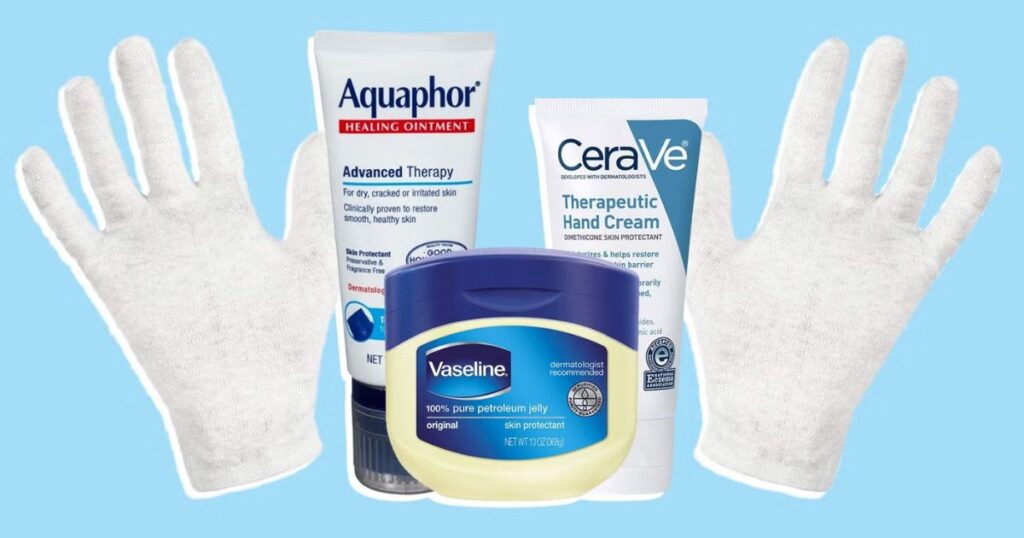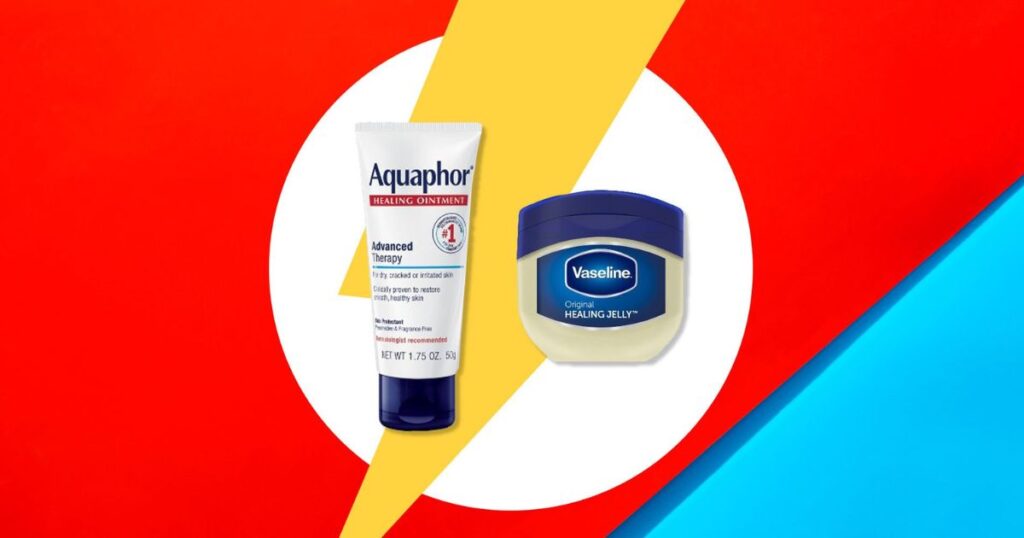Aquaphor vs. Vaseline: Which One Should You Choose? may seem similar at first glance, but they have distinct differences in composition and uses. Vaseline, or petroleum jelly, is a single-ingredient product made of 100% petroleum.
It’s been a go-to for dry skin and minor cuts for over 150 years. Aquaphor, on the other hand, is a more complex formulation that includes petrolatum along with other ingredients like mineral oil, ceresin, and panthenol.
These differences in ingredients lead to variations in texture, absorption, and potential applications. While both products excel at creating a protective barrier on the skin, they may be better suited for different scenarios.
Aquaphor vs. Vaseline: Which One Should You Choose?
In this post, we’ll dive deep into the pros and cons of each product, exploring their unique properties and best uses.
What Are Aquaphor and Vaseline?

First things first, let’s talk about what these products are.
Vaseline is a brand name for petroleum jelly. It’s been around for over 150 years and is known for its ability to lock in moisture and protect the skin. Vaseline is 100% pure petroleum jelly – nothing else added.
Aquaphor, on the other hand, is a bit newer (it’s been around since the 1920s) and has a few more ingredients. Its main ingredient is petroleum jelly, but it also contains other stuff to help your skin.
What’s Inside: Aquaphor vs. Vaseline?
Let’s break down what’s actually in these products:
Vaseline:
- 100% petroleum jelly
- That’s it!
Aquaphor:
- 41% petroleum jelly
- Mineral oil
- Ceresin
- Lanolin alcohol
- Panthenol
- Glycerin
- Bisabolol
As you can see, Aquaphor has more ingredients. But what do they do? Let’s find out!
Read More: ATFBooru: Your Ultimate Guide to the Creative Image Board
Understanding the Ingredients
- Petroleum jelly: This is the main ingredient in both products. It forms a barrier on your skin to lock in moisture.
- Mineral oil: Another oil that helps soften the skin.
- Ceresin: A wax that helps thicken the product.
- Lanolin alcohol: Comes from sheep’s wool and helps soften skin.
- Panthenol: A form of vitamin B5 that helps moisturize.
- Glycerin: Draws water to the skin to keep it hydrated.
- Bisabolol: Comes from chamomile and helps calm the skin.
How They Work: Occlusive Moisturizers?
Both Aquaphor and Vaseline are what we call “occlusive” moisturizers. This is a fancy way of saying they create a barrier on your skin. This barrier does two important things:
- It stops water from leaving your skin (keeping it hydrated).
- It protects your skin from outside stuff that might irritate it.
Think of it like wrapping your skin in a soft, protective blanket!
The Big Difference
The main difference between Aquaphor and Vaseline is pretty simple:
- Vaseline is just petroleum jelly. It’s great at creating that protective barrier.
- Aquaphor has petroleum jelly plus other ingredients that actively help your skin in different ways.
When to Use Aquaphor vs. Vaseline?

Both products are super useful, but they might work better for different things. Let’s look at some common uses:
Dry Skin
- Vaseline: Great for locking in moisture, especially if you put it on damp skin.
- Aquaphor: Might be better for very dry skin because it has extra moisturizing ingredients.
Chapped Lips
- Vaseline: Works well to protect lips and lock in moisture.
- Aquaphor: Might feel more soothing and healing, especially if lips are very chapped.
Minor Cuts and Scrapes
- Vaseline: Can help protect the wound and keep it moist for better healing.
- Aquaphor: Might be preferred because it has ingredients that can help soothe and promote healing.
Diaper Rash
- Vaseline: Creates a good barrier to protect baby’s skin.
- Aquaphor: Many parents prefer this because of the extra soothing ingredients.
Eczema
- Vaseline: Can help lock in moisture and protect irritated skin.
- Aquaphor: Often recommended by doctors for eczema because of its extra skin-helping ingredients.
How to Use Them?
Using Aquaphor and Vaseline is pretty easy, but there are a few tips to get the most out of them:
- Clean first: Always apply to clean skin. This stops you from trapping dirt or bacteria under the product.
- Use on damp skin: For best results, apply when your skin is slightly damp. This helps lock in that extra moisture.
- A little goes a long way: You don’t need a thick layer. A thin coating is usually enough.
- Be gentle: Don’t rub too hard, especially on irritated skin. Pat it on gently.
- Be patient: These products work best when used regularly over time.
Creative Uses for Aquaphor and Vaseline
These products aren’t just for dry skin! Here are some other ways people use them:
- Makeup remover: Great for getting off stubborn eye makeup.
- Cuticle softener: Rub a little on your cuticles to keep them soft.
- Prevent hair dye stains: Put a little around your hairline before coloring your hair.
- Heal cracked heels: Apply before bed and wear socks for super soft feet.
- Prevent chafing: Use in areas where skin rubs together, like thighs or underarms.
- Tame flyaway hairs: A tiny bit can smooth down frizzy hair.
- Prevent swimmer’s ear: A small amount around the ear before swimming can help.
Who Shouldn’t Use These Products?

While Aquaphor and Vaseline are safe for most people, there are a few cases where you might want to be careful:
- Wool allergy: If you’re allergic to wool, avoid Aquaphor. It contains lanolin, which comes from sheep’s wool.
- Very oily or acne-prone skin: These products might be too heavy and could make breakouts worse.
- Open or infected wounds: While they can help with minor cuts, don’t use on deep or infected wounds without talking to a doctor first.
- Sensitive skin: Some people might react to the ingredients. Always test on a small area first.
Making Your Choice: Aquaphor or Vaseline?
Remember, there’s no rule saying you can’t have both! Many people keep both products on hand for different uses.
So, which one should you choose? Here’s a simple way to decide:
Choose Vaseline if:
- You want a simple, one-ingredient product
- You’re on a tight budget
- You just need something to create a protective barrier
Choose Aquaphor if:
- Do you want extra soothing and healing benefits
- You have very dry or damaged skin
- You don’t mind paying a bit more for additional ingredients
Tips for Healthy Skin (Beyond Just Using Aquaphor or Vaseline)
While Aquaphor and Vaseline are great tools for skin care, they’re just part of the picture. Here are some other tips for keeping your skin healthy:
- Stay hydrated: Drink plenty of water to keep your skin moisturized from the inside out.
- Eat a balanced diet: Foods rich in vitamins and healthy fats can help your skin.
- Protect from the sun: Use sunscreen daily to prevent damage and premature aging.
- Be gentle: Don’t scrub too hard or use very hot water, which can strip your skin.
- Moisturize regularly: Use a good moisturizer suited to your skin type.
- Get enough sleep: Your skin repairs itself while you sleep.
- Manage stress: High stress can affect your skin health.
- Exercise: Good circulation from exercise can give your skin a healthy glow.
When to See a Doctor?
While Aquaphor and Vaseline can help with many skin issues, sometimes you need more help. See a doctor or dermatologist if:
- You have a skin condition that doesn’t improve or gets worse
- You have a rash that spreads or is very itchy
- You have signs of infection (redness, warmth, pus)
- You have sudden changes in your skin
- You’re not sure what’s causing your skin problems
The History of Aquaphor and Vaseline

It’s always fun to know a bit of history! Let’s look at where these products came from:
Vaseline
- Discovered in 1859 by Robert Chesebrough
- Chesebrough noticed oil workers using a gooey substance to heal their wounds and burns
- He purified this substance and called it “petroleum jelly”
- Vaseline was officially launched in 1870
- It quickly became popular for its many uses
Aquaphor
- Developed in 1925 by the Beiersdorf company (the same folks who make Nivea)
- Created as a base for medications
- Over time, it became popular as a skin protectant on its own
- The current formula was perfected in the 1950s
Interesting Facts About Petroleum Jelly
- During World War II, soldiers used petroleum jelly to protect their weapons from rust
- Some people eat a spoonful of petroleum jelly to help with constipation (but check with a doctor before trying this!)
- Petroleum jelly can be used to make candles in an emergency
- It’s sometimes used to help rescue wildlife affected by oil spills
Other Uses for Aquaphor and Vaseline
These products are super versatile. Here are some more ways people use them:
- Polishing leather: A tiny bit can make leather shoes shine
- Unsticking zippers: Rub a little on a stuck zipper to help it move
- Protecting pumpkins: Coating carved pumpkins can help them last longer
- Lubricating squeaky hinges: A dab can stop that annoying squeak
- Preventing rust on razors: A thin coat can keep your razor blades from rusting
- Easing ear pain on airplanes: Some people put a tiny bit around their ear openings to help with pressure changes
Alternatives to Aquaphor and Vaseline
Remember, everyone’s skin is different. What works great for one person might not be the best for another. If you’re looking for alternatives, here are a few options:
- Coconut oil: Natural and moisturizing, but can be comedogenic for some people
- Shea butter: Rich and nourishing, great for very dry skin
- Beeswax-based balms: Often used in natural skincare products
- Lanolin: From sheep’s wool, very moisturizing but some people are allergic
- Plant-based oils: Like jojoba, argan, or rosehip oil
The Science Behind Occlusive Moisturizers
Let’s get a bit nerdy for a moment! Occlusive moisturizers like Aquaphor and Vaseline work in a specific way:
- They create a physical barrier on top of your skin
- This barrier stops water from evaporating from your skin (called transepidermal water loss)
- By keeping water in, your skin stays hydrated
- Hydrated skin is healthier, more flexible, and looks better
It’s like wrapping your skin in a cozy, invisible blanket that keeps all the good moisture in!
Myths and Misconceptions
Let’s clear up some common misunderstandings about these products:
- Myth: Petroleum jelly is made from crude oil. Fact: It’s a byproduct of oil refining, but it’s highly purified and considered safe for skin use.
- Myth: These products add moisture to your skin. Fact: They lock in existing moisture but don’t add new moisture.
- Myth: You can’t use them if you have oily skin. Fact: You can, but use sparingly and be aware they might not be best for acne-prone areas.
- Myth: They’re only for very dry skin. Fact: They have many uses beyond just treating dry skin.
- Myth: More is always better. Fact: A thin layer is usually enough. Too much can feel greasy and uncomfortable.
Read More: The AI Music Honeymoon Phase Is Over
Comparing Aquaphor and Vaseline: A Detailed Look
Let’s break down the differences in a handy table:
| Feature | Aquaphor | Vaseline |
| Main ingredient | Petroleum jelly (41%) | Petroleum jelly (100%) |
| Other ingredients | Yes | No |
| Texture | Slightly less greasy | More greasy |
| Absorption | Absorbs a bit better | Sits more on top of the skin |
| Price | Generally more expensive | Generally cheaper |
| Best for | Very dry or damaged skin | Creating a simple moisture barrier |
| Scent | Very mild | Almost none |
| Allergic reactions | Possible (due to lanolin) | Very rare |
How to Store Aquaphor and Vaseline?
To keep your products in good condition:
- Keep the lid tightly closed when not in use
- Store in a cool, dry place
- Avoid leaving in direct sunlight
- Don’t let water get into the container
- If it starts to smell odd or change color, it’s time to replace it
Aquaphor and Vaseline in Different Climates
These products can be especially helpful in certain weather conditions:
- Cold, dry climates: Great for protecting skin from harsh winds and low humidity
- Hot, humid climates: Can create a barrier against sweat and friction
- High altitudes: Help combat the drying effects of thin air
- Beachy areas: Protect skin from drying salt water and sand
Aquaphor and Vaseline for Different Age Groups

These products can be useful at any age, but here are some specific uses:
- Babies: Diaper rash, dry patches, protecting cheeks from drool
- Children: Chapped lips, minor scrapes, eczema patches
- Teenagers: Dry skin from acne treatments, chapped lips from braces
- Adults: Dry hands, cracked heels, cuticle care
- Older adults: Extra dry skin, protecting fragile skin
Combining with Other Skincare Products
Aquaphor and Vaseline can be used with other skincare products, but there are a few things to keep in mind:
- Apply them last in your skincare routine
- They can help “seal in” other products like serums or moisturizers
- Be careful using them over products with active ingredients (like retinol) as they might increase absorption
Frequently Asked Questions
Can I use these products if I have eczema?
Many doctors recommend them for eczema. They can help protect the skin and lock in moisture.
Are Aquaphor and Vaseline safe to use during pregnancy?
Generally yes, but always check with your doctor, especially if you’re using them over large areas of skin.
Can these products help with scarring?
They can help keep the area moist, which may reduce scarring, but they don’t actively reduce existing scars.
Is it okay to use Aquaphor or Vaseline on my lips every day?
They’re safe for daily use on lips. Just be sure your lips are clean before applying.
Can I use these products on my tattoo?
But follow your tattoo artist’s instructions. They’re often recommended for the healing process.
Do Aquaphor and Vaseline have SPF?
They don’t provide sun protection. Always use sunscreen when you’re out in the sun.
Conclusion
When deciding between Aquaphor and Vaseline, it depends on your skincare needs. Aquaphor contains additional ingredients like lanolin and glycerin, making it great for healing dry, cracked skin and minor wounds. Vaseline, made of 100% petroleum jelly, is an excellent moisture barrier, ideal for protecting the skin from dryness.
If you need more intense healing properties, Aquaphor may be the better option. For basic skin protection and hydration, Vaseline is a simple and effective choice. Both products are affordable, safe, and widely available, so choosing one depends on your specific skin concerns.

